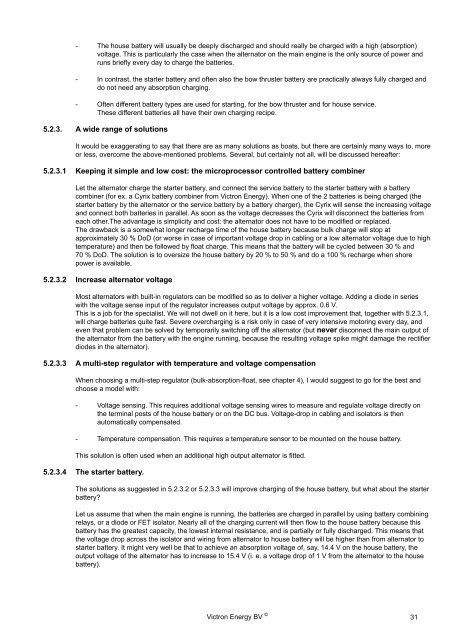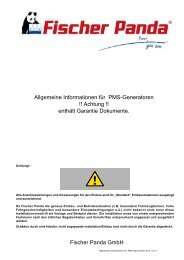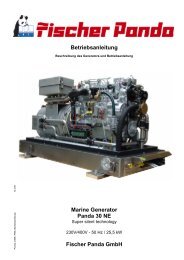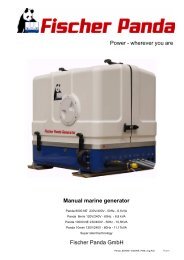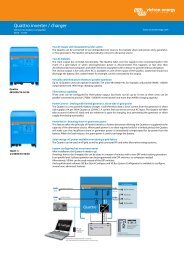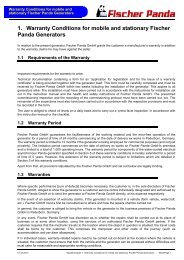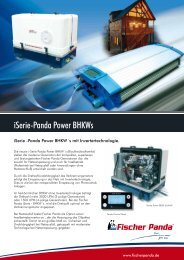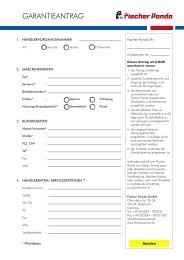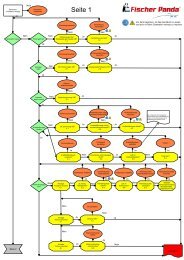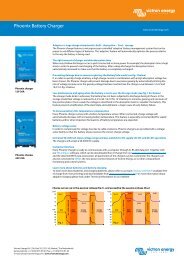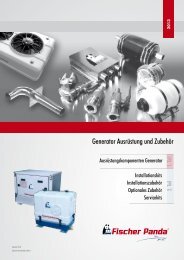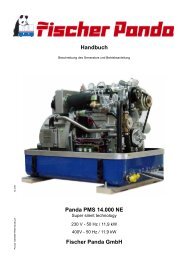Victron "Energy Unlimited" - Utu
Victron "Energy Unlimited" - Utu
Victron "Energy Unlimited" - Utu
You also want an ePaper? Increase the reach of your titles
YUMPU automatically turns print PDFs into web optimized ePapers that Google loves.
- The house battery will usually be deeply discharged and should really be charged with a high (absorption)<br />
voltage. This is particularly the case when the alternator on the main engine is the only source of power and<br />
runs briefly every day to charge the batteries.<br />
- In contrast, the starter battery and often also the bow thruster battery are practically always fully charged and<br />
do not need any absorption charging.<br />
- Often different battery types are used for starting, for the bow thruster and for house service.<br />
These different batteries all have their own charging recipe.<br />
5.2.3. A wide range of solutions<br />
It would be exaggerating to say that there are as many solutions as boats, but there are certainly many ways to, more<br />
or less, overcome the above-mentioned problems. Several, but certainly not all, will be discussed hereafter:<br />
5.2.3.1 Keeping it simple and low cost: the microprocessor controlled battery combiner<br />
Let the alternator charge the starter battery, and connect the service battery to the starter battery with a battery<br />
combiner (for ex. a Cyrix battery combiner from <strong>Victron</strong> <strong>Energy</strong>). When one of the 2 batteries is being charged (the<br />
starter battery by the alternator or the service battery by a battery charger), the Cyrix will sense the increasing voltage<br />
and connect both batteries in parallel. As soon as the voltage decreases the Cyrix will disconnect the batteries from<br />
each other.The advantage is simplicity and cost: the alternator does not have to be modified or replaced.<br />
The drawback is a somewhat longer recharge time of the house battery because bulk charge will stop at<br />
approximately 30 % DoD (or worse in case of important voltage drop in cabling or a low alternator voltage due to high<br />
temperature) and then be followed by float charge. This means that the battery will be cycled between 30 % and<br />
70 % DoD. The solution is to oversize the house battery by 20 % to 50 % and do a 100 % recharge when shore<br />
power is available.<br />
5.2.3.2 Increase alternator voltage<br />
Most alternators with built-in regulators can be modified so as to deliver a higher voltage. Adding a diode in series<br />
with the voltage sense input of the regulator increases output voltage by approx. 0.6 V.<br />
This is a job for the specialist. We will not dwell on it here, but it is a low cost improvement that, together with 5.2.3.1,<br />
will charge batteries quite fast. Severe overcharging is a risk only in case of very intensive motoring every day, and<br />
even that problem can be solved by temporarily switching off the alternator (but never disconnect the main output of<br />
the alternator from the battery with the engine running, because the resulting voltage spike might damage the rectifier<br />
diodes in the alternator).<br />
5.2.3.3 A multi-step regulator with temperature and voltage compensation<br />
When choosing a multi-step regulator (bulk-absorption-float, see chapter 4), I would suggest to go for the best and<br />
choose a model with:<br />
- Voltage sensing. This requires additional voltage sensing wires to measure and regulate voltage directly on<br />
the terminal posts of the house battery or on the DC bus. Voltage-drop in cabling and isolators is then<br />
automatically compensated.<br />
- Temperature compensation. This requires a temperature sensor to be mounted on the house battery.<br />
This solution is often used when an additional high output alternator is fitted.<br />
5.2.3.4 The starter battery.<br />
The solutions as suggested in 5.2.3.2 or 5.2.3.3 will improve charging of the house battery, but what about the starter<br />
battery<br />
Let us assume that when the main engine is running, the batteries are charged in parallel by using battery combining<br />
relays, or a diode or FET isolator. Nearly all of the charging current will then flow to the house battery because this<br />
battery has the greatest capacity, the lowest internal resistance, and is partially or fully discharged. This means that<br />
the voltage drop across the isolator and wiring from alternator to house battery will be higher than from alternator to<br />
starter battery. It might very well be that to achieve an absorption voltage of, say, 14.4 V on the house battery, the<br />
output voltage of the alternator has to increase to 15.4 V (i. e. a voltage drop of 1 V from the alternator to the house<br />
battery).<br />
<strong>Victron</strong> <strong>Energy</strong> BV ©<br />
31


